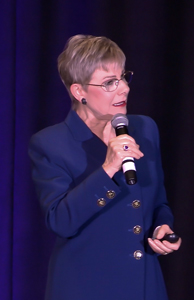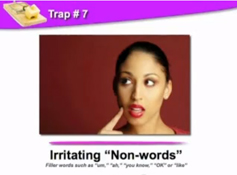
Whenever you open your mouth – whether your audience is one person or a thousand – you usually want to get a message across. Maybe you want your opinions heard at meetings, or you’re giving a formal presentation. Possibly, you’re even in a position to advise your sales team or CEO on an important presentation.
Anyone who sets out to present, persuade, and propel with the spoken word faces 10 major pitfalls:
1. UNCLEAR THINKING. If you can’t describe what you are talking about in one sentence, you may be guilty of fuzzy focus or trying to cover too many topics. Your listeners will probably be confused too, and their attention will soon wander. Whether you are improving your own presentations or helping someone else to create a speech, start your creative process by jotting down a one-sentence summary.
2. NO CLEAR STRUCTURE. Make it easy for people to follow what you are saying. They’ll remember it better–and you will too as you deliver your information and ideas. If you waffle, ramble, or never get to the point, your listeners will tune out.
3. NO MEMORABLE STORIES. People rarely remember your exact words. Instead, they remember the mental images that your words inspire. Support your key points with vivid, relevant stories. Help your audience “make the movie” in their heads by using memorable characters, exciting situations, dialogue, suspense, and humor.
 4. NO EMOTIONAL CONNECTION. The most powerful communication combines both intellectual and emotional connections. Intellectual means appealing to educated self-interest with data and reasoned arguments. Emotion comes from engaging the listeners’ imaginations, involving them in your illustrative stories by frequent use of the word “you” and from answering their unspoken question, “What’s in this for me?” Use a high I/you ratio. For example: Not “I’m going to talk to you about telecommunications,” but “You are going to learn lots of exciting things about telecommunications.” Put the listener in the story. Not, “I want to tell you about Bobby Lewis,” but “Come with me to Oklahoma City. Let me introduce you to my friend, proud father Bobby Lewis.” You’ve put the listener in the story.
4. NO EMOTIONAL CONNECTION. The most powerful communication combines both intellectual and emotional connections. Intellectual means appealing to educated self-interest with data and reasoned arguments. Emotion comes from engaging the listeners’ imaginations, involving them in your illustrative stories by frequent use of the word “you” and from answering their unspoken question, “What’s in this for me?” Use a high I/you ratio. For example: Not “I’m going to talk to you about telecommunications,” but “You are going to learn lots of exciting things about telecommunications.” Put the listener in the story. Not, “I want to tell you about Bobby Lewis,” but “Come with me to Oklahoma City. Let me introduce you to my friend, proud father Bobby Lewis.” You’ve put the listener in the story.
5. WRONG LEVEL OF ABSTRACTION. Are you providing the big picture and generalities when your listeners are hungry for details, facts, and specific how-to’s? Or are you drowning them in data when they need to position themselves with an overview and find out why they should care? Get on the same wave length with your listeners. My friend Dr. David Palmer, a Silicon Valley negotiations expert, refers to “fat” and “skinny” words. Fat words describe the big picture, goals, ideals, outcomes. Skinny words are minute details and specific who, what, when, and how. In general, senior management needs fat words. Middle management requires middle words. Technical staff and consumer hot line users are hungry for skinny words.
6. NO PAUSES. Good music and good communication both contain changes of pace, pauses, and full rests. This is when listeners think about what you’ve just said. If you rush on at full speed to crowd in as much information as possible, chances are you’ve left your listeners back at the station. It’s okay to talk quickly, but whenever you say something profound or proactive or ask a rhetorical question, pause.
7. IRRITATING NON-WORDS. Hmm…ah…er…you know what I mean… One speaker I heard began each new thought with “Now!” as he scanned his notes to figure out what came next. This might be okay occasionally, but not every 30 seconds. Record yourself to check for similar bad verbal habits.
8. STEPPING ON THE PUNCH-WORD. The most important word in a sentence is the punch-word. Usually, it’s the final word: “Take my wife–PLEASE.” But if you drop your voice and then add, “Right?” or “See?!” you’ve killed your message.
9. NOT HAVING A STRONG OPENING AND CLOSING. Engage your audience immediately with a powerful, relevant opening that includes the word “you.” Don’t close with questions. Ask for them, if appropriate, then deliver a dynamic closing. Last words linger.
10. MISUSING TECHNOLOGY. Timid speakers who simply narrate flip chart images, slides, videos, overheads, or view-graphs can rarely be passionate and effective. Make technology a support to your message, not a crutch. One trap is that information presented through technology tends to be about the speaker and the speaker’s organization, while communication should be about the AUDIENCE. One sales presentation I was asked to critique had 60 PowerPoint slides–58 about the company but only 2 about the prospective client. At my suggestion, they reversed the ratio.
Avoiding these 10 common traps is the first step to changing dull-and-boring speaking into dynamic, powerful, and persuasive communication.
My executive speech coaching clients include corporate leaders, celebrity speakers, well-known sports and media personalities, and sales teams.
![]()
Would you like Patricia Fripp as your personal speech coach 24/7?
“I wanted a super bowl-quality coach, and I was lucky to be introduced to Patricia Fripp. Her help in coaching and scripting was world class. With Patricia Fripp on your team, you can go places.”
– Don Yaeger, Long-Time Associate Editor for Sports Illustrated magazine, Award-Winning Keynote Speaker, New York Times Best-Selling Author
Join FrippVT today!
Executive Speech Coach and Hall of Fame Keynote Speaker Patricia Fripp works with individuals and companies who realize that powerful, persuasive presentation skills give them a competitive edge.

Thanks for another great article and video! I especially like your point about using memorable stories. I’ve linked to it from my blog so my readers can benefit from your wisdom also.
http://gildabonanno.blogspot.com/2013/06/patricia-fripps-ten-pitfalls-to-avoid.html